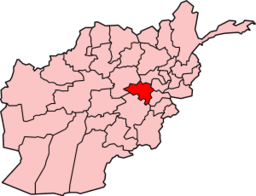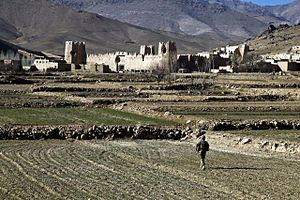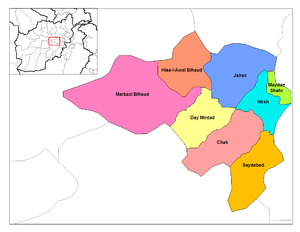- Wardak Province
-
Maidan Wardak (وردګ) Province Country Afghanistan Capital Meydan Shahr - coordinates 34°24′N 68°24′E / 34.4°N 68.4°E Area 9,934 km2 (3,836 sq mi) Population 540,100 [1] Density 46.2 / km2 (120 / sq mi) Timezone UTC+4:30 Main languages Pashto
Dari PersianMaidan Wardak Province (also spelled Wardag, or Vardak, Pashto: میدان وردګ Persian: میدان وردک, [warˈdak]) is one of thirty four provinces of Afghanistan located in the central east region of Afghanistan. It has a population of approximately 540,100. The capital of the province is Maidan Shar. The majority of the population is Pashtun.
Contents
History
During the communist times, the people of Maidan Wardak never gave significant support to the communist government.[2] Maidan Wardak Province was significant during the Civil War in Afghanistan, due to its proximity with Kabul and its agricultural lands. Hizb-e Islami, Ittehad-i Islami and Hezb-e Wahdat all had significant presence in the area. Most of the area was captured by the Taliban around winter 1995, and after the capture of Kabul, Maidan Wardak Taliban were significant in the fight for Parwan Province and Kapisa.[2]
Geography
Maidan Wardak province is located in the Central (or Central East) region of Afghanistan; bordering Parwan to the Northeast, Kabul and Logar to the east, Ghazni to the south and Bamyan to the west. The capital of Wardak province is Maidan Shahr, which is located about 35 km from Kabul. Wardak province covers an area of 9,934 km2. The majority of the provincial population (527,750 people) live in rural areas. The most heavily populated areas are along the Kabul – Kandahar Highway. The rest of the province is thinly populated, with villages concentrated in areas with available irrigation and water sources (CSO and UNFPA, 2003).
Demographics
The provincial population is approximately 540,100. 70% are Pashtuns, the major ethnic group in the province.[3] Pashtuns of the Wardag tribe inhabit the following districts: Chak, Sayedabad, Jaghatu and Day Mirdad (65%). Pashtuns of different tribes (Andar, Sheenzi, Autmanzi), inhabit Nirkh district. In Jalrez district about 45% of the population are Kharoti Pashtuns, and 65% of the population in the provincial capital Maidan Shar are Pashtun, the majority of which are Amarkhel.[4][5] Kuchis migrate across parts of Sayadabad, Daymirdad and Nerkh between April and September. There are ongoing conflicts between settled and nomadic groups in the Behsud districts, regarding access to pastureland.
27% of the people in the province are Persian or hazaragi-speaking Hazaras and Tajiks.[3] The two Behsud districts in the western part of Wardak are predominantly populated by Hazara.
Religion
The province is recognized for its strong religious sentiment. Between the 1950s-1970s over 30 study centres were active in the area, run by Deoband graduates.[2]
Politics
The Provincial Governor, Muhammad Halim Fidai replaced Abdul Jabbar Naeemi in July 2008. He was born in Paktika province and holds a masters degree in Public Relations.
Political parties and actors
There is a wide range of political actors operating in Wardak province. The three key parties are Hezbi Islami (HiG), one faction of the former Hizb-i Wahdat, Hizb-i Wahdat-i Islami-i Mardom-i Afghanistan, and the Taliban. Government appointments were contested after the fall of the Taliban government in 2001 (see above), but have settled into a pattern in which Hezbi Islami related actors have been given significant positions in the police and governor's office.
This is in contrast to the Hizb-i Wahdat-i Islami-i Mardom-i Afghanistan, which has done better at the ballot box and is linked to a number of the elected MPs and Provincial Councils members (though officially in both elections parties did not stand, only candidates).
The Taliban exercise both military and political presence in the province. Taliban forces in Wardak have been estimated at about 800 lightly armed men, split into dozens of different factions (Burke, 2008). However, a Taliban Commander, active in Wardak province, claimed having 6,000 fighters, and claimed that the Taliban controlled three quarters of the province. Although these figures are likely exaggerated, the Taliban are reported to have been freely moving at night, which gives the impression to local people that there is a high level of Taliban presence in the province (BBC, 2008).
The Taliban in Wardak kept a low profile during 2002, and many fled to Pakistan. By 2005, Taliban forces started to return to the province, focusing on reactivating old networks and exploiting the situation: there were a range of factors favourable to the Taliban, for example anger about civilian casualties caused by the military actions of the international forces, anger of the villagers at the corrupt government, and overall insecurity. The Taliban started preaching against the international forces, and by end of 2007 the Taliban started their recruitment process among the Wardak population (Burke, 2008). The Provincial Governor has denied that the Taliban have influence in the province, claiming that the government has absolute control and the Taliban do not have the support of the people (Leithead, 2008).
Wardak has 5 representatives in the Wolesi Jirga: two independent, two from the Hizb-i Wahdat-i Islami Mardom-i Afghanistan party, and one member is from the Hizb-i Harakat-i Islami Mardom-i Afghanistan. Interestingly, although the majority of the population of Wardak are Pashtun, three of the elected representatives from Wardak are Hazaras. The Wardak Provincial Council has nine members, eight of whom declared that they were independent. The ninth elected member is Mohammad Hussain Fahimee, who is Hazara from the Hizb-i Wahdat-i Islami Mardom-i Afghanistan party.
In the 2004 presidential elections, Hamid Karzai (Pashtun, Independent), received 60.8% of the vote of the province; Haji Mohammad Mohaqiq (Hazara, Independent) received 32.7%; and the Tajik Yonous Qanooni from Hizb-i Nihzat-i Milli Afghanistan received 2.7%. These results reflect some of the ethnic composition of Wardak. Significantly, 42% of voters in Wardak were women.
The Taliban commander as of December 2008 was Qomendan Hemmet[6] who took over when the previous commander died in 2005.
Security
The security situation rapidly deteriorated in Wardak in 2008 and 2009. According to a report by Mohammad Osman Tariq Elias, both Logar and Wardak, by the end of 2008, were under de facto Taliban control.[2] As of April 2009, the Ministry of Interior had listed the entire province except hissa awal e Behsud districts as "High Risk."[7] A report from the New York Times in October had changed this to describe the entire province including Behsud as "Taliban Controlled."[8]
Economics & Industry
In terms of industry, one marble factory is working in the province, and there are marble mines in the provincial centre and Sayed Abad District although no mining is currently undertaken there due to the government ban. The majority of commercial activity in Wardak is related to trade in agricultural and livestock products, although stone quarrying is also a growing business in the area. The people from Wardak are also expert in karez cleaning and repair and go to other parts of the country for this purpose. In Wardak, there are many natural resources like petroleum, iron, rubies, and many historical artifacts that have been found by the people, but have been kept secret.
Agriculture is a major source of revenue for 43% of households in Wardak province. Four fifths (79%) of rural households own or manage agricultural land or garden plots in the province. However, nearly a quarter (24%) of households in the province derive income from trade and services, and around half (45%) of households earn some income through non-farm related labor.
Education
The overall literacy rate in Maidan Wardak province is 25%. There are around 251 primary and secondary schools in the province catering for 105,358 students. There are 2909 teachers teaching in these schools.[3]
Districts
Districts of Wardak Province District Capital Population[9] Area[10] Ethnical data(%)[11] Notes Chak 83,376 1,273 Day Mirdad 28,865 Hisa-I-Awali Bihsud 25,079 Jaghatu 46,667 Shifted from Ghazni Province in 2005 Jalrez 44,873 Markazi Bihsud 94,328 Maidan Shar 35,008 85% Pashtuns, 14% Tajiks, 1% Hazaras Narkh 56,354 80% Pashtuns, 15% Tajiks, 5% Hazaras Saydabad 114,793 1,163 In war
Wardak Province was where the 2011 Chinook shootdown in Afghanistan occurred.
Members of I Corps Artillery (deactivated and is now 65th Fires Brigade) of the Utah National Guard served on Police Mentor Teams (PMTs) with the Afghan National Police throughout Wardak Province.[citation needed]
References
- ^ Central Statistics Office of Afghanistan. "Settled Population of country by Provinces and sex for 2006-2009 years". http://www.cso.gov.af/demography/population.html. Retrieved 2009-11-30.
- ^ a b c d Elias, Mohammed Osman Tariq (2009). "The Resurgence of the Taliban in Kabul, Logar and Maidan Wardak". In Giustozzi, Antonio. Decoding the New Taliban: Insights from the Afghan Field. Hurst & Company. ISBN 978-1-85065-961-7.
- ^ a b c http://www.mrrd.gov.af/nabdp/Provincial%20Profiles/Wardak%20PDP%20Provincial%20profile.pdf
- ^ http://www.cpau.org.af/Research/Docs_our_publications/Wardak%20Conflict%20Analysis%20Apr%2009%20Final.pdf
- ^ http://www.pashtoonzar.blogfa.com/post-9.aspx
- ^ Abdul-Ahad, Ghaith. "Face to Face with the Taliban." The Guardian. 14 December 2008. Accessed at: http://www.guardian.co.uk/world/2008/dec/14/afghanistan-terrorism
- ^ British Broadcasting Corporation. Afghanistan: Security Map. 19 August 2009. Accessed at: http://news.bbc.co.uk/2/hi/south_asia/8194230.stm Accessed on [28 September 2009]
- ^ New York Times. "Two Talibans." 23 October 2009. Accessed at: http://www.nytimes.com/imagepages/2009/10/23/world/23tbmap.html [Accessed on 6 November 2009]
- ^ http://www.mrrd.gov.af/nabdp/Provincial%20Profiles/Wardak%20PDP%20Provincial%20profile.pdf Wardak Provincial Profile - MRRD
- ^ Afghanistan Geographic & Thematic Layers
- ^ Ethnic demographic statistics taken from http://www.aims.org.af
External links

Bamyan Province Parwan Province Kabul Province 

 Wardak Province
Wardak Province 

Ghazni Province Logar Province Provinces of Afghanistan Badakhshan · Badghis · Baghlan · Balkh · Bamyan · Daykundi · Farah · Faryab · Ghazni · Ghor · Helmand · Herat · Jowzjan · Kabul · Kandahar · Kapisa · Khost · Kunar · Kunduz · Laghman · Logar · Nangarhar · Nimruz · Nuristan · Oruzgan · Paktia · Paktika · Panjshir · Parwan · Samangan · Sar-e Pol · Takhar · Wardak · Zabul
Categories:
Wikimedia Foundation. 2010.



